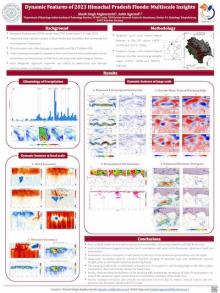Dynamic Features of 2023 Himachal Pradesh Floods: Multiscale Insights
Akash Singh
Raghuvanshi
Ph.D. Scholar, Department of Hydrology, Indian Institute of Technology Roorkee, Uttarakhand, India
Poster
Using rainfall observations and reanalysis products, this study examines the dynamics of the extreme precipitation event that caused the catastrophic flood in Himachal Pradesh, India in 2023. It shows that prior to the flood, periods of moderate rainfall moistened the mountainsides, increasing their susceptibility to flash floods and landslides. Unique characteristics were noted locally, including rapid convergence, vertical velocity, relative humidity, relative vorticity, and moisture flux accumulation; however, these variables weakened following the intense precipitation event that resulted in the flood, suggesting a cloud burst like event. A large-scale circulation pattern connecting the extratropic and monsoonal low, which is conducive to intense precipitation in the Himachal Pradesh region, is also revealed by the study. This pattern includes an unusual convergence of a monsoon low moving westward across the mid-upper level and an eastward-propagating trough that extends southward across India. A Rossby wave train structure and a blocking high west of the features are the key elements of this unusual convergence. Two days before the extreme precipitation event, the Rossby wave-breaking effect occurred downstream of the blocking high. This allowed high potential vorticity stratospheric air to intrude the equator and troposphere, causing surface pressure changes and enhanced vertical motion, advecting anomalous moisture and causing 2023 catastrophic floods in the Himachal Pradesh region.

Poster file
Meeting homepage
